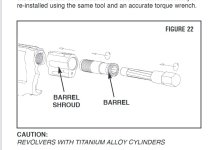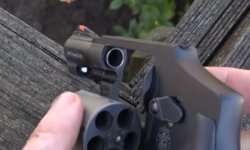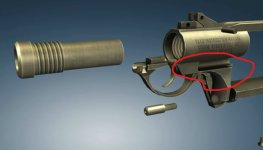I am considering a snubby, I am comparing between S&W scandium alloy 357 like 340PD and Ruger LCR 38spc +P. If I change the grip of the LCR, both will be the same size. Both are about 12 to 13oz.
I started talking about this in the other thread, I don't want to hijack that thread, so I am starting my own. Bill DeShivs talked about the problem of frame cracking and Carmady provided this picture:

I had a S&W M37 J frame air weight, I was very concern with the exact area. I was so uncomfortable I sold it long time ago after only about 200 to 300 rounds. I still have 2 M36 which is steel J frame. I still a little concern as it's very thin in that area.
I have been looking at the construction between the 340PD and the LCR, so far, this is what I gathered, I conclude that LCR is still better, I want to hear other's that look into this to share their opinion. This is how I come to the conclusion:
1) 340PD, The frame design is the same as the old J frame where the barrel screw onto the frame and should have the same weak point as shown in the following:


You can see, the same weak area as the old J-frame, the difference is it is using scandium alloy that is supposed to be stronger. But does that make up the difference? Is it stronger than steel?
2)Here is the design of Ruger LCR. Notice the thread of the barrel is at the FRONT of the barrel. The outer barrel is actually part of the frame, there is no thin spot, at the critical area like S&W, in the red circle area, the whole area is taking the stress, not at one spot. This is very beefy, just as strong as the upper part of the frame.

I never have a chance to see the real gun in person, can only rely on the pictures I found online. Please put in your opinions.
Thanks
I started talking about this in the other thread, I don't want to hijack that thread, so I am starting my own. Bill DeShivs talked about the problem of frame cracking and Carmady provided this picture:
I had a S&W M37 J frame air weight, I was very concern with the exact area. I was so uncomfortable I sold it long time ago after only about 200 to 300 rounds. I still have 2 M36 which is steel J frame. I still a little concern as it's very thin in that area.
I have been looking at the construction between the 340PD and the LCR, so far, this is what I gathered, I conclude that LCR is still better, I want to hear other's that look into this to share their opinion. This is how I come to the conclusion:
1) 340PD, The frame design is the same as the old J frame where the barrel screw onto the frame and should have the same weak point as shown in the following:
You can see, the same weak area as the old J-frame, the difference is it is using scandium alloy that is supposed to be stronger. But does that make up the difference? Is it stronger than steel?
2)Here is the design of Ruger LCR. Notice the thread of the barrel is at the FRONT of the barrel. The outer barrel is actually part of the frame, there is no thin spot, at the critical area like S&W, in the red circle area, the whole area is taking the stress, not at one spot. This is very beefy, just as strong as the upper part of the frame.
I never have a chance to see the real gun in person, can only rely on the pictures I found online. Please put in your opinions.
Thanks





